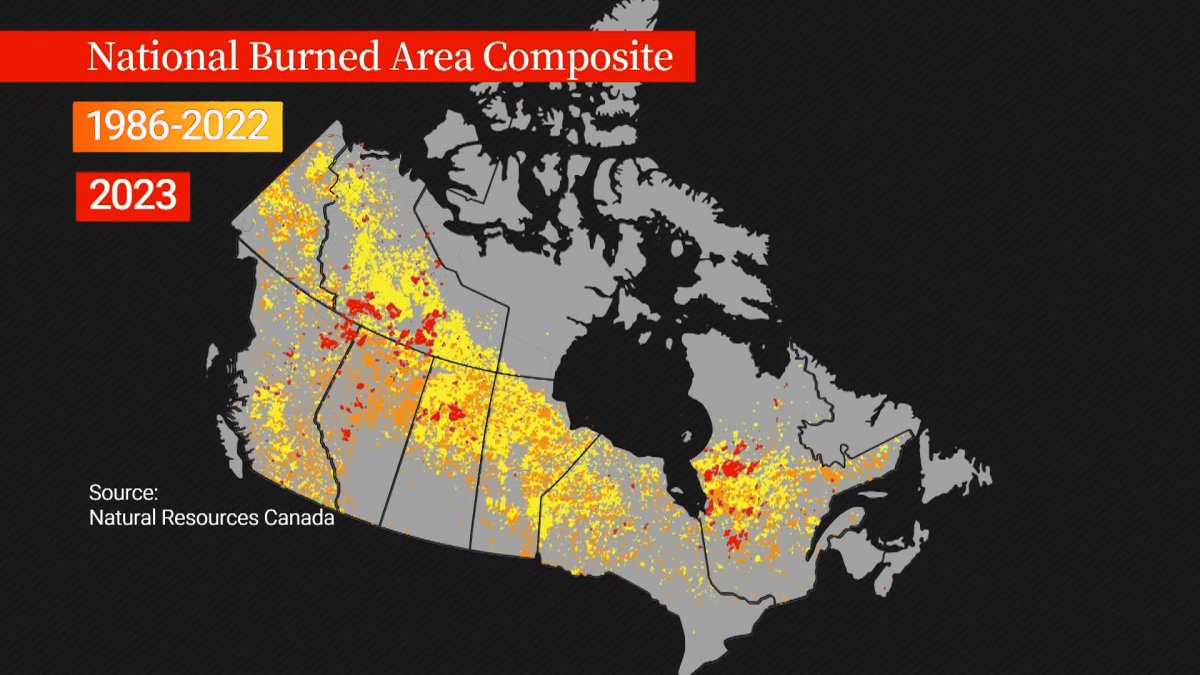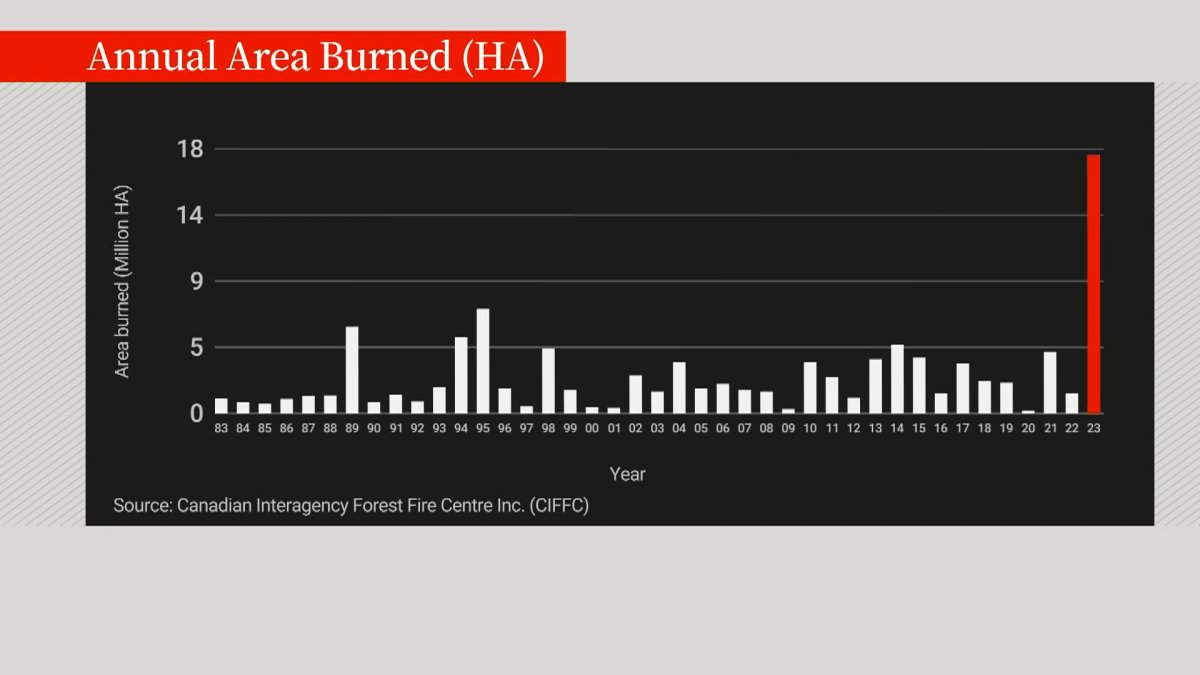After a record-breaking wildfire season, 6,517 forest fires have burned 18.5 million hectares (46 million acres) of land in Canada throughout 2023, about five per cent of the entire forest area of Canada, and more than 10 times the amount of last year.

According to the Canadian Interagency Forest Fire Centre’s final report of the year, 769 active fires were still burning throughout Canada with 345 categorized as “out of control,” 186 as “being held,” and 238 considered to be under control.
The land that has burned so far this year is about double the size of Portugal. All 13 provinces and territories were affected to varying degrees, with tens of thousands evacuated and at least four firefighters killed.
As the Canadian wildfire season slowly winds down with cooling temperatures, what happens to all the land and forests after the fires have been extinguished and nearby evacuated communities returned, especially with such a large swath of area affected?
Most forest ecosystems in Canada are fire-adapted and wildfires were historically a part of the natural lifecycle, according to University of Toronto’s Faculty of Forestry professor emeritus David Martell. In a traditional year, forest fires could trigger new growth, reduce diseases and clean out the forest floor, with forests going through a process of several years of re-generation after being entirely or partially burnt down.
“Fire is a natural ecosystem process and we can’t nor should we attempt to completely exclude fire from our forests,” says Martell, adding that fire behaviour and impact on forest ecosystems differ across the country, depending on the local environment.
In fact, some species of trees, such as Jack and Lodgepole pine, need the heat of a fire to open up their cones to release seeds, with shoots from trees such as aspens rising out of smouldering forests before coniferous trees eventually take over. Not long after, animals such as nighthawks and woodpeckers come to feed on fire beetles before larger animals such as elk and deer feed on fresh shoots.
What Has Changed Over Time
In the past, fires didn’t come around an area more often than every 30 years, with the lack of trees from recent burns helping regulate the frequency of the fires and resetting the local ecosystem.
But now, experts warn that climate change may be breaking that natural cycle. With warmer air drying out moisture from soils and trees, forests are being left behind as tinderboxes susceptible to lightning strikes or accidental sparks. A recent study by World Weather Attribution found that human-caused climate change more than doubled the likelihood of extreme fire weather conditions in eastern Canada.
This combination of factors leads to increasing frequency, severity and intensity of wildfires spread across a longer fire season. And the increasing frequency and severity of wildfires in Canada’s boreal forest may be permanently changing one of the largest intact ecosystems left on Earth, researchers suggest.
“These changes in both frequency and intensity — specifically in boreal forests — are producing some shifts in how our forests are re-establishing after a fire,” says Ellen Whitman, a forest fire scientist with Natural Resources Canada.
Long-Term Impacts
Instead of the natural regeneration of the past, Dark Days at Noon: The Future of Fire author Edward Struzik believes the intensifying fires can now burn so hot in some places that they “incinerate” seeds and destroy nutrients in the soil necessary for trees to come back. Seeds may never get the chance to regenerate or young seedlings may not be able to mature enough for their own seed bank before another wildfire hits them.
In this case, Struzik believes we may see a kind of “desertification,” with forests being replaced by deciduous trees such as aspen and white birch or even grassland. Adding that a warming climate means that boreal forests will migrate northwards, Struzik says that “the southern end of our boreal forest is going to disappear.”
Canada’s boreal forest has historically served as a carbon sink, holding about 12 per cent of the world’s land-based carbon reserves from its leaves to its roots, according to Boreal Conservation. That’s equivalent to up to 36 years of global carbon emissions from burning fossil fuels.
This summer, data from Copernicus Atmosphere Monitoring Service shows that carbon emissions from Canada’s wildfires reached over 405 megatonnes by mid-September. That’s as much as Mexico’s entire carbon emissions from 2021, and represents 27 per cent of the total global wildfire carbon emissions for 2023 so far.
Scientists worry that the transformation of the forest from carbon sink to carbon source will create a feedback loop, where the carbon released from the boreal forest further contributes to climate change, which is primarily caused by the burning of fossil fuels — thereby accelerating the conditions that lead to more fires.
“I think that it’s certainly going to be a wake-up call for a lot of decision-makers in government and also in the insurance industry and people living in the boreal forest of Canada, which covers most of Canada,” says Struzik, who was hosting a family evacuated from the Northwest Territory wildfires at the time of the interview.
Future
“Business as usual is not going to be successful in dealing with the fire situation that is unfolding,” Struzik says. “We can’t be dealing with fire the way we were dealing with it in the 20th century. It’s a new 21st-century phenomenon, and there has got to be new strategies to deal with this situation.”
To do so, Struzik believes that a wildfire strategy coordinated on the national level is a vital first step, involving federal, provincial and municipal governments as well as Indigenous and business companies.

With these changes, researchers such as Struzik and Whitman believe that the restoration of peatlands, Indigenous-led prescribed burning, national organization and learning to live with fire will be key to how we move forward. This may include rethinking how homes and communities are built to minimize the risks in the event of an approaching fire.
As the wildfire season winds down and emergency crews will finally be able to catch their breath, Whitman expects that groups of field personnel, policymakers and researchers will be able to debrief and take stock of what happened in this record-breaking year.
“The timescales over which these sorts of phenomena are shaped are longer than single years. This is something that forestry and disturbance ecology teaches — We need to think at long timescales,” says Patrick James, an associate professor at the University of Toronto.
“The best time to make investments into these systems and to improve our situation was yesterday. The second best time is today.”
Reporting for this story was made possible, in part, by a fellowship with the Institute for Journalism & Natural Resources







Comments